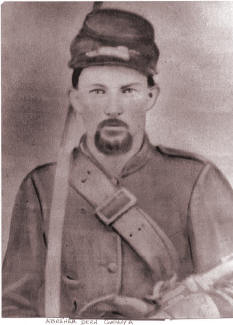












 Sit back & just enjoy more of the Maryland countryside & a wee bit of its rich history.
Sit back & just enjoy more of the Maryland countryside & a wee bit of its rich history.~ NEW MARKET ~ ~ "Antiques Capital of Maryland"
The community was named after New Market, England
| |||||
~ WOODSBORO ~
Woodsboro During the Civil War
Military Operations of Woodsboro
John Allen Miller
Emmitsburg Historical Society
|
Private Abraham Dern of Woodsboro |
During the outbreak of the Civil War Woodsboro, Maryland was mainly sympathetic to the Union cause. Several men from Woodsboro joined many of the Union units including the 7th Maryland Infantry. Abraham Dern who grew up in Woodsboro, joined Company A of Cole's Cavalry and returned home after the war's close. On November 14, 1861, for protection of loyal Union men at the polls of the late election, Major Stone served as the provost Marshall of Woodsboro and a few other election precincts. Because Maryland was so divided in it's political views, no armed men went near the polls.
In October of 1862, Confederate General JEB Stuart and his cavalry made their way across the Potomac. Their objective was to capture the Union depots at Chambersburg, Pennsylvania. After completing his objective, General Stuart led his men back toward Hagerstown when he realized that a portion of Union Cavalry is following him. General Stuart orders his men to march toward Gettysburg. After passing through Cashtown, General Stuart decides to travel to Fairfield and make his way to Emmitsburg, Maryland. Just one hour before the Confederate arrival in Emmitsburg, 140 men of the 6th Pennsylvania Cavalry known as Colonel Rush's Lancers had passed through the town. A courier was captured carrying dispatch to Colonel Rush notifying him that 800 Cavalrymen under Union General Pleasonton was in pursuit of Stuart's Cavalry.
At a half past 10 p.m. on the night of October 11th, a company of the 6th Pennsylvania Cavalry observed General Stuart's column marching through Woodsboro. Corporal John Anders of Company D, Rush's Lancers gallantly scouted the Confederates at Woodsboro. He dismounted and entered Woodsboro on foot. He talked freely to the men of Stuart's Cavalry until he was detained for suspicion of being a Union Loyalist. Corporal Anders managed to escape and rejoined his unit shortly after midnight. Two prisoners that were taken at Fairfield, Pennsylvania by the names of Hartman and Sheads made their escape at Woodsboro, Md.
Before the battle of Gettysburg, on June 29th, 1863, marching orders at 4 a.m. were carried out. Portions of the Union Army would march through Woodsboro on their way to Middleburg. The 12th Corps and the 3rd Corps along with their corresponding Artillery would march through Woodsboro followed by General Meade's Headquarters wagon train. General Farnsworth's Brigade of Cavalry also traveled through Woodsboro as they headed toward Taneytown.
Union General Slocum commanding the 12th Corps wrote to General Meade at Woodsboro about delays occurring with the Union wagon trains upon Woodsboro Pike. Because of the wagon situation, this was slowing his Corps and they would not make it to Middleburg on time and would be forced to encamp at the double Pipe Creek near the Frederick and Carroll County line. Colonel Warren Packer commanding the 5th Connecticut Volunteers also encamped for the night at Woodsboro.
After the battle of Gettysburg, Woodsboro witnessed many of the same troops marching to Frederick, trying to get in front of General Robert E. Lee's Confederate Army. On July 7th, the 12th Corps and 2nd Corps marched through Woodsboro on their way to Frederick. Many officers were impressed with the beauty of Woodsboro and how well were the condition of the roads. At 8 p.m. the Artillery reserve was ordered to encamp at Woodsboro and would resume their march to Frederick early in the morning of July 8th.
In June of 1864, Confederate General Robert E. Lee sent a corps of men under the command of General Jubal Early northward from Petersburg, Virginia to conduct a campaign that would threaten Washington. Many Maryland towns would see troops from both sides come through their towns much as they did during the Gettysburg Campaign a year earlier. Woodsboro was not exception. On July 9th, 1864 during the battle of Monocacy, the Chairman of Executive Committee David Willis reported that Confederate Cavalry had scouting parties at Woodsboro and were reported stealing horses and robbing stores.
Today, Woodsboro still holds the same appearance as it did during the Civil War. Although Woodsboro has grown over the past decade, the modern day convinces and the quarry has not taken any of the historical aspects on Main Street. Woodsboro is located on modern day Route 194 where it connects to modern day Route 550.
Read other articles by John Miller on the civil war
~ THURMONT ~Thurmont During the Civil War
Mechanicstown 1861-1862
Rarely known for its Civil War history, the ever-growing town of Thurmont and its neighboring town of Emmitsburg have seen their share of the Civil War. At the time of the Civil War, Thurmont was known as Mechanicstown and has a very unique Civil War history that most people are surprised to hear. No battles were fought in Mechanicstown, but more of a mishap of opportunities.
During the year of 1860, the state of Maryland was in turmoil. Many families were forced to take sides and many even fought against each other. William Seabrook best sums up what Maryland was going through: "Troops were brought down from the North for the defense of Washington. The feeling of the Marylanders was shown by the conduct of a mob, who attacked the soldiers during their passage through Baltimore, and killed some of them. The establishment of these troops at Washington cut off Maryland from the other Southern States and withheld her from following her natural bent and joining the new Confederacy."
During the late election of November 1861, the Secretary of War sent troops for the protection of Union men at the polls. Union Major Stone served as the provost-marshal for the areas of Woodsborough, Myersville, Wolfsville, Emmitsburg, Wolf’s Tavern, and Mechanicstown sent troops of infantry and cavalry out in protection of pro-union men voting, however, no armed men went near the polls, and no serious disturbance occurred in this part of the State.
General JEB Stuart with 1800 troopers and General Pelgram’s Battery of two to four guns made their way to the Potomac River and on October 9th, 1862 crossed a ford near Clear Springs, Maryland. This raid into Maryland and Pennsylvania was made completely around General McClellan and was known as the Chambersburg Raid. General Stuart’s orders were to capture equipment, disrupt communication lines, destroy parts of the C&O Canal and also take out parts of the B&O railroad at and near Chambersburg. After completing his objectives, General Stuart made his way into Cashtown, Fairfield, and reached Emmitsburg at about sunset on October 11th, 1862.
General Alfred Pleasonton who was commanding the Federal Cavalry Corps was tracking General Stuart’s whereabouts. He thought that General Stuart was retracing his footsteps back toward the Potomac River in the direction in which he came, but Stuart headed east and the pursuit was on. General Pleasonton arrived at Mechanicstown around 8.30 p.m. and immediately sent scouts in the direction of Emmitsburg, Taneytown, Middleburg, Graceham and Gettysburg picketing all the roads in that vicinity.
At around 9:00 p.m., portions of Stuart’s Cavalry reached Rocky Ridge where they met a Federal scouting party of General Pleasonton’s. Around 10:30 p.m. Stuart’s Cavalry observed the passing through Woodsboro. Stuart’s location was dispatched to General Pleasonton only few miles away at Mechanicstown.
The Federal Cavalry had several opportunities to attack Stuart’s Cavalry at Emmitsburg and Rocky Ridge. Because of the false intelligence and missed opportunities this allowed General Stuart to safely get away.
Read other articles by John Miller on the civil war
~~~ VOTE for my friends barn restoration ~~
http://www.helpgrowyoursoup.com/barn_waitsee.aspx
~~~ GIVEAWAY ~~~
http://rebecca-gatheryeroses.blogspot.com/
& VOTE for Rebecca @
http://www.divinecaroline.com/awards/Aug-09/2032-a-gathering-of-thoughts
~~~ Pray of blessings for those that we know or do not know that are in need








Nothing like going on a drive on a beautiful day. We did some antiquing lately on one such day last week. Can't beat the fun and enjoyment! ; )
ReplyDelete~Michele
Howdy Marydon, I loved your post today the barn pictures are wonderful. I found some pictures for you and set up another blog you can snag the pictures from there just go to http://htmlblogcodes.blogspot.com/ I have found a few I think you may like. Take care sweety.
ReplyDeleteBlessings,
Heidi
Very pretty pictures of the countryside. I love the barns.
ReplyDeleteVery beautiful countryside Marydon!
ReplyDeleteThanks for the giveaway info as well.
Many blessings sweet friend. ~Melissa :)
Marydon: You are always willing to educate us. I love that about you. Great post. Blessings, Martha
ReplyDeleteHi Marydon,
ReplyDeleteWhat a great post full of wonderful photos and information. I enjoyed it very much.
Have a great day,
Elizabeth
Hello Marydon, love your beautiful posts of the countryside, especially the old barns and silos... just had to tell you, my great~great~great grandfather was John Lorimer Worden, Captain of the Monitor of the famous battle between the Monitor and the Merrimack... (this was on my mama's side of the family)...thanks for sharing more meaningful parts of history... Bisous... Julie Marie
ReplyDeleteDear Blushing Rose lady, I have something for you my dear, over at The Plumed Pen Blog..,
ReplyDeleteLove the photos especially the fourth one of that gorgeous house.
ReplyDeleteThe only thing I know about Newmarket in England is it has a racecourse.
Very interesting info you posted! Love the pictures. And yes,I like barn pictures as much as you! Enjoy!
ReplyDeleteI think I need a trip to Maryland. Definitely will put it on my list. Have been to Baltimore and through Maryland, but need to see this area. Thanks so much for sharing.
ReplyDeleteOh my! The most beautiful scenic pictures! That day must have been beautiful! We finally got a day of sunshine after almost 2 weeks of grey overcast skies and rain ~ yuck. I am already sick of winter and it's not even here yet! Love the pictures of your sweet grandkids in the kitchen. I bet they have a great time at your house.
ReplyDeleteHugs,
Gail
Hi Marydon, Beautiful fall pics of the countryside. Wonderful inspiration.
ReplyDeleteThank you for sharing the history lesson as well. You always have interesting info.
Have a great week.
Blessings, Celestina Marie
You have such history back east. Your post was amazing. The Civil had to have been horrific for families. All the pictures of your scenery were beautiful as always. No outhouses though?!
ReplyDeleteThose photos were so pretty...such beautiful farms and buildings. Thanks for sharing!
ReplyDelete